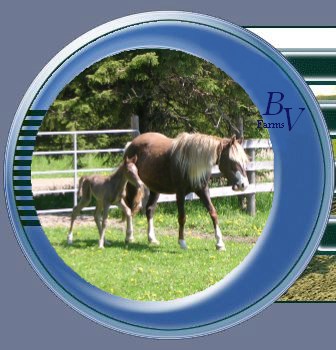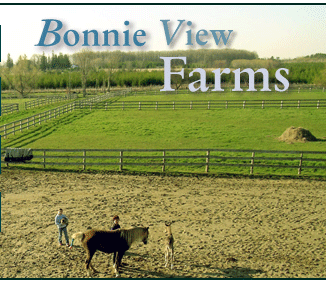MCOA Facts:
MCOA is not unique to
Mountain Horses; it
occurs in all breeds that
carry the silver dapple
gene. Such as Morgans,
Bashkir-Curlies,
Halflingers, Shetland
Ponies, Miniature
Horses, etc.
MCOA cysts are located
well outside of the eye's
line of sight, & therefore
do not affect the horse's
vision at all. They also
do not cause the horse
any pain. They simply
indicate that the horse
has at least one copy of
the abnormal eye gene.
Even the full MCOA eye
syndrome rarely ever
affects the horse's vision
(Less than 1 in 1000
horses have impaired
vision caused by MCOA).
Any horse that has the
silver dapple gene also
has at least one copy of
the MCOA eye gene.
A heterozygous silver
dapple horse has one
copy of the MCOA eye
gene, & will either have
cysts only, or be clear
eyed showing no MCOA
symptoms at all (silent
carrier).
A homozygous silver
dapple horse has two
copies of the MCOA eye
gene, & will most likely
have the full MCOA
syndrome.
Black & bay based coat
colour horses can never
hide the presence of the
silver dapple gene; so
these horses will never
have MCOA.
Chestnut horses & other
red based coat colours
(eg. palomino, cremello,
strawberry roan, gold
champagne, red dun,
etc.) can hide the
presence of the silver
dapple gene & so too
the presence of the
MCOA eye gene.
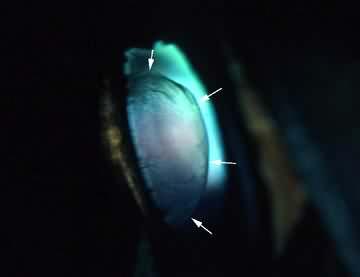
Photograph: Oblique
profile of the lateral
anterior segment of the
right eye of a Rocky
Mountain Horse. The
arrows point to a large,
translucent cyst caused
by MCOA.
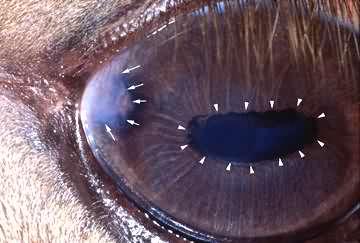
Photograph: External
view of the left eye of a
Rocky Mountain Horse with full MCOA
syndrome. The arrows
indicate a section of the
iris which is stuck to the
cornea (iridocorneal
adhesion). The arrow
heads point out the
ridges in the iris and the
irregular shape of the
pupil.
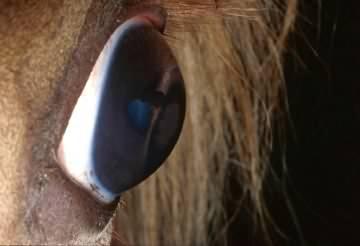
Photograph: External
view of the left eye of a
Rocky Mountain Horse
with pop eyes (cornea
globosa) caused by
MCOA.
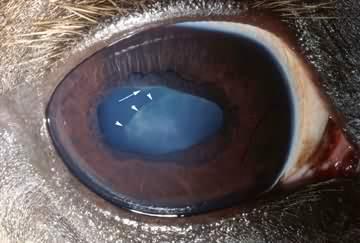
Photograph: External
view of the right eye of a
Rocky Mountain Horse
with full MCOA
syndrome. The arrow
indicates a section of the
lens which has begun to
fall. The arrow heads
point to a cataract in the
lens.
|
The Scoop on ASD
MCOA = Multiple Congenital Ocular Anomalies
ASD = Anterior Segment Dysgenesis
Introduction:
The first thing to know is that the name for this condition has been changed. The reason for this change is that the term ASD was developed for how the condition appears in horses (specifically). Since that time, similar conditions with similar genetics have been identified in a number of other animal species. The changes in the eye from one species are somewhat different from those in another species. Therefore a more general term was developed, which is Multiple Congenital Ocular Anomalies (MCOA). Other than the name having changed, nothing else has.
MCOA is a change in the structure of the eye of the horse, caused by a change in one of the genes that controls eye development. This change is referred to as a mutation. All animal bodies use one basic building material: protein. Our DNA is packaged together into many chromosomes, and different animal species have different numbers of chromosomes. Our chromosomes contain our genes, and it is our genes which are the blue prints to make proteins. Proteins are long strings of smaller units, called amino acids, that are stuck together in a very specific way. When that string is finally finished and put together it folds in on itself in a very specific shape. It is that shape that carries out the function of that specific protein. Because of the way proteins are put together there are an infinite number of different proteins possible. Each protein that is made in the body is designed to do one job, if that protein is not made properly then it can't do its job and that's when problems arise.
While researchers have not yet identified the gene for MCOA, they are getting very close. They know that it is on equine chromosome number six, and that it lies very close to the PAMEL 17 gene which is the silver dapple gene. The silver dapple gene is responsible for the many beautiful chocolate colours in the Mountain Horse, and in multiple other horse breeds too. Most likely these two genes are very close neighbors, like living on the same block, although there is a small possibility that the silver dapple gene and the gene for MCOA are one in the same. Whether they are different genes or the same makes little difference, since they are so closely linked to each other that it is very unlikely that they will ever be separated.
With that in mind it becomes extremely important that all owners and breeders of Mountain Horses understand exactly what MCOA is, and what changes it can cause to the horse. In order to clearly understand this it is important to first learn some basic genetics. All genes occur in pairs, for example humans have 23 pairs of chromosomes and horses have 32 pairs. Each new generation gets one copy of the pair from the father and the other from the mother. When the parents build the egg or the sperm that go into the makeup of a new generation they put only one of their two copies into either the egg or the sperm. Which one they put in is random so that you never know which one the offspring will get from either parent. However if we know the characteristic that the gene governs we can look at several generations of animals and see how the inheritance shows up in each generation. This process was originally worked out by an Austrian monk by the name of Gregor Mendel in the mid-1800s using of all things, peas.
Many studies have shown us that a gene that governs a function in an animal has different forms that make that gene have either dominant or recessive behaviour. What this means is that the two copies of any one gene can be slightly different, and therefore can make a slightly different protein. The dominant gene, and its protein, is more effective in its job than the recessive form. So that when you see the animal you see only the effect of the dominant protein. Now if you get two copies of the gene that are both recessive, then of course that's the only protein being made and that's what you see in the animal. In some instances genes are co-dominant. What that means is that you have two different genes but they have about equal ability to produce functioning proteins. As a result if you have two copies that are normal you'll see no effect. If you have one copy that is abnormal and one copy that is normal you will see a slight effect. If you have two copies that are abnormal you'll see a full effect. In the MCOA gene system the abnormal gene is a co-dominant gene. That's what gives us the horse that has normal eyes, the horse that has cysts only, and the horse that has the full complement of eye changes associated with MCOA.
The shorthand terminology that researchers use to express all of this is pretty simple. The normal form of the gene has been assigned the letter a, and the form of the gene that is abnormal has been assigned the letter A. So when talking about a horse's eyes, since it has two copies of the gene, it could have either aa, Aa or AA. From looking at many horses and knowing the general rules of inheritance researchers know that a horse with the aa gene pattern will have normal eyes. The horse with the gene pattern Aa will have cysts, and the horse with AA will have the full MCOA syndrome. Because of the relationship between the MCOA eye gene and the silver dapple gene we have been able to show that if a horse has the silver dapple gene it will have at least one abnormal copy of the MCOA eye gene (A). Since it is not always easy to tell, simply by looking at the horse, if a horse has one copy of the silver dapple gene or two copies it is also not possible to tell whether the horse has one or two copies of the abnormal eye gene without carefully examining the eyes. Certainly, if a DNA test has shown that the horse has two copies of the silver dapple gene, then it is assumed that the horse also has two copies of the abnormal eye gene as well.
Since it is relatively easy to distinguish a horse with normal eyes or one with cysts, from a horse with the full set of abnormal genes it makes it is also relatively simple to pick out the horse with two abnormal copies of the MCOA eye gene. The first step in determining if a horse has two copies of the abnormal gene is to carefully look at the eyes. The normal eye has a nice oval pupil surrounded by the iris (colored part of the eye). In addition, if you take the horse and look at the eye in a bright light you'll find that that pupil is quite small. If you then walk the horse into a dark stall, and let it stand there for a few minutes, and then take a little flashlight and look at the eye with the light off to the side so it doesn't shine directly into the eye it will show that that pupil has grown much larger. Your veterinarian can also use a dilation drug to show the same thing, that the pupil will go from very small to very large fairly rapidly. If you have ever gone to an eye doctor and had your eyes examined you may know how that works. Horses that have the full MCOA syndrome have eyes that do not dilate (englarge) and contract (shrink down) rapidly.
As well, when you look at the horse's iris, the colored part of the eye, you may see little holes in it. You may also see ridges running from the outer edge to the pupil, rather than having creases running around the eye that you see in a normal eye. This evaluation should be done with EVERY horse that has the silver dapple gene which means: chocolate, red chocolate, chocolate roan, silver buckskin, silver champagne, silver dun, etc. Even chestnut horses, and other red based colors like palomino, cremello, strawberry roan, gold champagne, red dun, etc. should be examined for MCOA as these colours can hide the presence of the silver dapple gene. If a horse is going to be bred this testing is especially necessary. The only way to distinguish a normal horse from a horse that has cysts only, is through examination by an equine ophthalmologist. Horses that are aa or Aa have eyes that are normal in all other ways.
The next important thing to consider is what do the eye changes caused by MCOA do to the horse. There has been a lot of misinformation on the internet and in the general horse magazines about this condition. Dr. David T. Ramsey DVM is a world leader in research and understanding of MCOA. He has done multiple tests on more than 3000 horses, mostly Rocky Mountain Horses, and has developed a very solid database on how the eyes of the horse are affected.
Silver Dapple Horses With Cysts Only (Aa):
Let's first consider the horse with one copy of the abnormal eye gene, these horses have cysts only. The first thing to remember is that as most animals, even people, age they tend to develop cysts in their eyes. These cysts are not the cysts of MCOA, they occur in a different part of the eye, and may or may not affect vision. The cysts of MCOA only occur in one area of the eye, and that is way up in front of the eye just beyond the base of the pupil on the outside part of the eye. Because those cysts are so far out of the way of the light coming into the eye that allows the horse to see, they have absolutely no effect on the vision of the horse. These horses have adequate muscles in the colored part of the eye to open and close it, so the horse gets all the light in it needs. The result is that these cysts do not affect the functional vision of the horse. Most importantly it has been shown over and over again that these cysts do not cause the horse any pain. The bottom line is MCOA cysts do not affect the horse's vision; they simply tell you that there is at least one copy of the abnormal eye gene present in that horse.
Silver Dapple Horses With Full MCOA (AA):
In the horse with two copies of the abnormal eye gene there are a number of changes that occur. The most obvious change is that the pupil does not dilate and contract properly, because the iris itself is actually thinned out and lacks a lot of the muscle that makes it function properly. The iris can also have little holes in it. The iris can also have ridges running from the outer edge to the pupil, rather than having creases running around the eye that you see in a normal eye. In addition these horses can develop, in the area where the cysts would be, areas where the retina (the light-sensitive part of the eye) comes loose from its supporting layers. Since, as in the case of the horse with cysts, the affected areas are out of the line of vision they do not have any impact on the horse's vision. If an area of the retina does come loose the horse's eye automatically tacks it back down. Dr. Ramsey has shown that in some horses this can happen over and over again in that outside part of the eye. So long as the area where the retina has come loose gets tacked back down again there is no impact on the horses vision. However, whenever there is a tear in the retina fluid from the center of the eye could get in behind and cause the retina to detach. If that happens then the horse would lose it's vision in that eye. Luckily, this possibility is extremely rare! In the over 3000 horses that Dr. Ramsey has examined he has only ever seen this happen in three or four cases.
Another change that occurs due to the abnormal eye gene is that the cornea, the clear outer part of the eye, can become extremely prominent and over round. This condition is called cornea globosa, or more commonly called “pop eyes”. The corneas are perfectly clear and light can pass through them very easily, but because there is a longer distance to the back of the eye and because they've got a greater curvature pop eyes bend the incoming light more than they should. The way all eyes see is by focusing the beam of light coming into the eye on to a very small spot in the back of the eye on the retina. That spot is called the fovea centralis. If the shape of the horse's eye causes that incoming light to becomed focused before it reaches the fovea centralis, then the horse will be nearsighted. If the light focuses further back beyond the retina, then the horse will be farsighted. A foal that is born with very large pop eyes is going to be very nearsighted, and can sometimes bump into things. This often makes people think those foals are blind, they are not blind they are just terribly nearsighted. In 2001 Dr. Ramsey and a group from the University of Ohio optometry school carefully examined 15 of these pop eyed horses along with 15 normal horses. All of the pop eyed horses had been previously checked when they were young foals, and were then examined again at 10 months or older. What was amazing is that when Dr. Ramsey and his team examined these pop eyed foals later as young adults they were no longer nearsighted! The pop eyes were still present, but the lens had become much thinner allowing the light to bend much more normally. In addition the growth of the eye, that normally takes place, was much less in the front to back direction. So that by the time the eye reached full size for an adult the distance from the lens to the retina turned out to be much shorter than the eye of a normal horse. Essentially, what all of this did was to structurally changed the eye so that the incoming light focused where it was supposed to. As a result those horses, who had had been so terribly nearsighted as foals, then had normal vision by the time they were 10 months old or older. In fact comparing the 15 normal eyed horsed to the 15 with the pop eyes, the pop eyed horses as adults had slightly better vision than the normal eyed horses!
There are also other problems that can develop with horses with two copies of the abnormal eye gene. The most severe of which is that the fibers that hold the lens in place can become very weak and let the lens literally fall down flat in the eye. That sounds terrible, but actually horses don't use their lenses very much at all. Horses have very little muscle connected to their lens to change their shape. Humans, on the other hand, when they are young do quite a lot of lens changing to focus the light more critically. That's why as we age we end up needing bifocals. In horses without a lens, which is basically what happens when it falls all the way down, the lens is simply out of the way and they have more than adequate vision. They might be slightly farsighted but this does not cause any problems from that standpoint. Lenses that have fallen down are more susceptible to developing cataracts, but if the lens is out of the way of the incoming light it really doesn't make any difference because the cataract that could form would also be out of the way of the incoming light.
Finally lenses, even in the normal position, can often get cataracts. These however are not the kind of cataract that blinds a horse. The lens of the eye is made up into two layers, an outer tougher layer and an inner softer layer. The cataracts from MCOA occur around the periphery of the eye where those two layers join. Remember the only part of the lens that actually works is the center. The cataracts of MCOA are outside of that line of light and do not affect vision. The only time they have any impact on vision is if some uninformed ophthalmologist tries to take the lens out because of the cataract. That has happened three or four times and all of those horses wound up blind. With that cataract in place and the lens in place those horses had perfectly normal vision and that cataract should never have been removed. Now, remember that horses with MCOA can develop ordinary cataracts just like any other horse. Those cataracts can affect vision but they have nothing to do with the presence of MCOA.
Silent Carrier Silver Dapple Horses (Aa):
Remember, because of the relationship between the MCOA eye gene and the silver dapple gene any horse that has the silver dapple gene will also have at least one abnormal copy of the MCOA eye gene (A). However, there is another situation that can occur, and that is that sometimes the effect of the abnormal eye gene is not demonstrated. Geneticists call this incomplete penetration. This is what occurs when a silver dapple horse does not show any MCOA symptoms at all. It simply means that the abnormal eye gene is there but for some other reason, and researchers have no idea what that is, the horse does not demonstrate the abnormal eye gene's presence. If a horse is examined and found to be clear eyed, but carries atleast one copy of the silver dapple gene, then it is called a silent carrier or “Clear Eyed”.
Breeding Silver Dapple Horses:
If a horse that has cysts only is bred to another horse with cysts only then the chances are one in four that the foal is going to have the full MCOA syndrome. If a horse with full MCOA is bred to a horse with cysts only then half of the foals will have full MCOA. If a full MCOA horse is bred to another full MCOA horse, then all resulting foals will have the full MCOA syndrome. The full MCOA syndrome is a condition that should be avoided in the Mountain Horse breeds as much as possible. So only clear eyed silver carriers should be bred to other clear eyed silver carriers, and homozygous silver carriers should never be bred to other silver carriers. That will reduce to a minimum the incidence of the full MCOA syndrome. |
|
